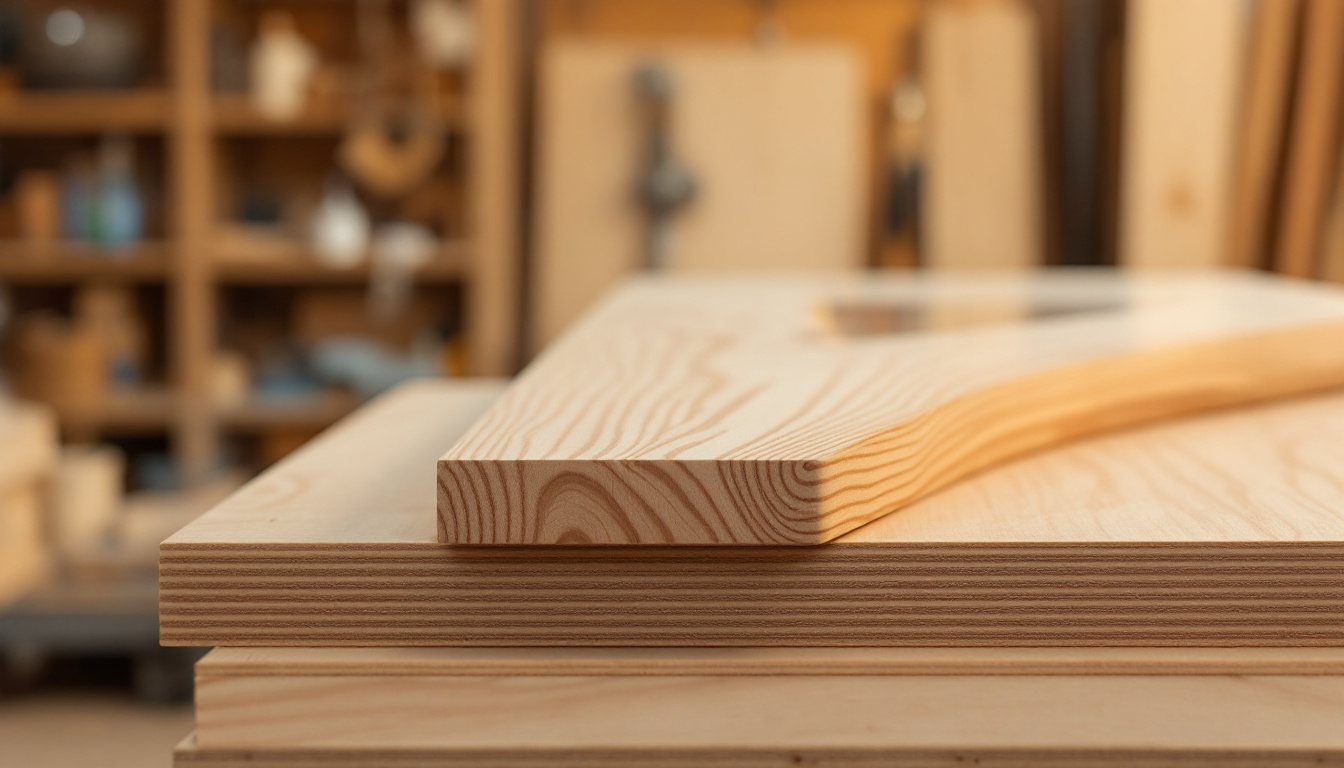Formwork Plywood (also known as formply) is a versatile and widely used construction material made from layers of wood veneers. It is a type of structural plywood that offers superior strength, durability, and cost-effectiveness, making it an ideal choice for various construction projects, including concrete formwork, walls, floors, and bridges. Plywood is constructed from multiple layers of wood veneers, typically made from pine or hardwood, which are glued together using a high-density overlay (HDO) phenolic resin. This construction process imparts superior strength, stiffness, and dimensional stability to the plywood, making it suitable for high-performance applications.
Plywood is a versatile building material widely used in construction, furniture making, and various DIY projects. Its strength, durability, and aesthetic appeal make it a popular choice among builders and craftsmen alike. However, not all plywood is created equal. Different grades of plywood are available, each with unique characteristics and applications. Two common grades are F14 and F17, which are often considered in the context of structural applications. Plywood’s capacity to maintain structural integrity over multiple uses makes it particularly valuable in high-stress construction settings and large-scale projects.
Understanding the differences between these grades is essential for selecting the right plywood for specific projects. This article will explore the characteristics, applications, and advantages of F14 and F17 grade plywood, helping you make an informed decision for your next undertaking.
Understanding Stress Grades
Stress grades are a critical factor in determining the suitability of plywood for various construction applications. Stress grades, such as F17, indicate the plywood’s structural rating and its ability to withstand different loads and stresses. F17 formply, for example, is a high-strength plywood suitable for demanding construction projects, including concrete formwork, tilt-up panels, and bridge construction. Understanding stress grades is essential to ensure that the selected plywood meets the required specifications and can withstand the anticipated loads and stresses.
What is F14 Grade Plywood?
F14 grade plywood is a structural plywood that meets specific performance criteria set by the Australian and New Zealand standards. This grade is typically used in applications where moderate strength and durability are required. F14 plywood is made from multiple layers of wood veneer, including pine veneers, bonded together with adhesive, which enhances its strength and resistance to warping.
The reliability of F14 grade plywood makes it a dependable choice for various applications, ensuring consistent performance in both residential and commercial construction projects.
Characteristics of F14 Grade Plywood
The F14 grade is characterised by its thickness, typically ranging from 9mm to 25mm. It is designed to withstand a certain amount of load, making it suitable for various structural applications. The plywood is manufactured using high-quality timber, ensuring that it meets the required standards for strength and durability. Additionally, F14 grade plywood is stable, exhibiting minimal expansion or contraction when exposed to changing environmental conditions.
Another notable feature of F14 plywood is its surface finish. It often has a smooth finish, making it suitable for applications where aesthetics are important, such as furniture and cabinetry. Additionally, F14 plywood is treated to resist moisture, making it a viable option for outdoor use, provided it is adequately sealed. Its durability also makes it suitable for repeated use in construction projects.
Applications of F14 Grade Plywood
F14 grade plywood is commonly used in residential and commercial construction. It is ideal for flooring, wall sheathing, and roofing applications where moderate strength is necessary. Additionally, F14 grade plywood is suitable for constructing large decks due to its durability. Furthermore, it is often employed in the manufacture of furniture, cabinetry, and decorative panels, thanks to its attractive finish and structural integrity.
In addition to construction and furniture making, F14 plywood is also utilised in the production of formwork for concrete structures. Its strength and durable nature make it a reliable choice for temporary structures that require stability during the curing process.
What is F17 Grade Plywood?
F17 grade plywood is another type of structural plywood, but it is designed to meet higher performance standards than F14. This grade is recognised for its superior strength and load-bearing capabilities, making it suitable for more demanding applications. Like F14, F17 plywood is constructed from layers of wood veneer, but the quality of the timber and the adhesive used can differ significantly. F17 grade plywood also offers a high quality finish, providing a smooth and cleanable surface that enhances overall project quality.
In addition to its strength, F17 grade plywood is highly versatile and can be used in various construction applications, including precast elements and tilt-up panels.
Characteristics of F17 Grade Plywood
F17 plywood typically has a higher thickness range, often starting from 12mm and going up to 25mm or more. This increased thickness contributes to its enhanced load-bearing capacity, making it suitable for heavy-duty applications. The manufacturing process for F17 plywood also involves stricter quality control measures, ensuring that only the best materials are used. Additionally, F17 grade plywood exhibits minimal expansion or contraction when exposed to wet weather or varying temperatures, enhancing its stability for large area applications.
Moreover, F17 plywood is engineered to resist warping and delamination, even under challenging environmental conditions. This makes it an excellent choice for projects that require long-lasting performance and stability. The surface finish of F17 plywood is also smooth, allowing for easy painting or staining, which is beneficial for aesthetic purposes. F17 grade plywood can also be easily shaped with everyday tools, making it adaptable for various construction needs.
Applications of F17 Grade Plywood
The applications for F17 grade formply are extensive and varied. It is often used in commercial construction, particularly in high-rise buildings and structures that require enhanced load-bearing capabilities. F17 grade plywood is also utilized in constructing columns due to its structural integrity. F17 plywood is also commonly used in the manufacture of heavy-duty furniture, such as office desks and conference tables, where strength and durability are paramount.
In addition, F17 plywood is frequently employed in the production of scaffolding and temporary structures, where safety and stability are critical. Its robust nature and lighter weight compared to other materials make it an ideal choice for applications that demand high performance over extended periods.
Concrete Formwork Applications
Concrete formwork is a critical application of plywood, where it is used to create smooth, high-quality concrete surfaces. Plywood formwork is ideal for concrete slab construction, as it provides a smooth, even surface that can be easily removed after the concrete has set. The high-density overlay of the plywood ensures that it can withstand the moisture and pressure of the concrete, while its structural integrity and stability prevent bending or warping. Plywood formwork is also suitable for non-structural applications, such as creating architectural features or decorative elements.
Key Differences Between F14 and F17 Grade Plywood
While both F14 and F17 grade plywood serve essential roles in construction and manufacturing, several key differences set them apart. Understanding these differences can help you choose the right grade for your specific needs. The bond used in F17 grade plywood, often involving a strong adhesive like phenol formaldehyde resin, enhances its strength and durability.
F17 grade plywood is also commonly used in constructing frames for various structures, providing a stable and versatile option for repetitive use in concrete formwork.
Strength and Load-Bearing Capacity
The primary difference between F14 and F17 plywood lies in their strength and load-bearing capacities. F17 plywood is designed to support heavier loads compared to F14, making it more suitable for demanding applications. If a project requires a higher level of structural integrity, F17 should be the preferred choice. Additionally, the reliability of F17 grade plywood ensures dependable performance in various architectural demands, making it ideal for commercial construction applications.
Thickness and Construction Quality
F17 plywood typically comes in thicker options than F14, which contributes to its enhanced strength. Made from a combination of hardwood and pine veneers, the construction quality also varies, with F17 plywood undergoing more rigorous quality control measures during production. This ensures that F17 plywood is less likely to warp or delaminate over time, providing a more reliable solution for critical applications.
Cost Considerations
Due to its superior strength and quality, F17 plywood generally comes at a higher price point than F14. When budgeting for a project, it is essential to consider the specific requirements and whether the additional cost of F17 plywood is justified. For projects that do not require the enhanced performance of F17, F14 may be a more cost-effective option. F17 grade plywood is particularly valued for its durability and capacity to maintain structural integrity over multiple uses in high-stress construction settings.
Choosing the Right Plywood for Your Project
When deciding between F14 and F17 grade formply in Australia, it is crucial to assess the specific requirements of your project. Consider factors such as load-bearing needs, environmental conditions, and aesthetic preferences. By evaluating these elements, you can make an informed decision that ensures the success of your project. The versatility of F14 grade plywood makes it adaptable for various construction applications, meeting diverse architectural demands.
F17 Formwork Plywood is known for its rigidity and minimal expansion or contraction when exposed to changing environmental conditions. This stability allows for easier installation over large areas, particularly in wet environments where concrete formwork is used.
Consulting with Experts
For those unsure about which grade of plywood to choose, consulting with industry experts can provide valuable insights. Professionals in the field can offer guidance based on their experience and knowledge, helping you select the most suitable plywood for your needs. The reliability of expert advice ensures that you make informed decisions, leading to better outcomes in your projects. You can contact Covert Procurement today to discuss your project and find something suitable for your needs.
Quality Assurance and Compliance
Regardless of the grade chosen, it is essential to ensure that the plywood complies with relevant Australian and New Zealand standards. This compliance guarantees that the plywood has been manufactured to meet safety and performance requirements, providing peace of mind for builders and consumers alike. Additionally, the bond used in plywood construction, often involving a strong adhesive like phenol formaldehyde resin, is crucial for ensuring durability and moisture resistance in building applications.
Environmental Considerations
Environmental considerations are becoming increasingly important in construction projects, and plywood is no exception. Sustainable forestry practices and responsible sourcing of wood veneers are essential to minimize the environmental impact of plywood production. Many plywood manufacturers, including those producing F17 formply, prioritize sustainability and comply with environmental regulations, such as the Forest Stewardship Council (FSC) certification. Additionally, plywood can be reused multiple times, reducing waste and minimizing the demand for new materials. By choosing plywood from sustainable sources and using it efficiently, construction projects can reduce their environmental footprint and contribute to a more sustainable future.
Choosing Structural Plywood in Australia
In summary, the differences between F14 and F17 grade plywood are significant, particularly concerning strength, load-bearing capacity, and cost. F14 grade plywood is suitable for moderate applications, while F17 grade plywood excels in demanding environments where enhanced performance is required. Understanding these distinctions is vital for making informed decisions in construction and manufacturing. Both F14 and F17 grade plywood are known for their reliability, ensuring dependable performance in various architectural demands.

By carefully considering the specific needs of your project and consulting with experts when necessary, you can select the right formply grade to ensure the success and longevity of your work. Whether you choose F14 or F17, both grades offer unique benefits that can contribute to the overall quality and durability of your construction projects. Additionally, the durability of F17 grade plywood allows for multiple uses in high-stress construction settings, making it particularly valuable for large-scale projects requiring reliable materials.

